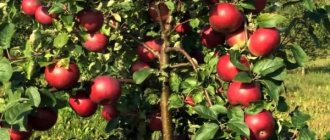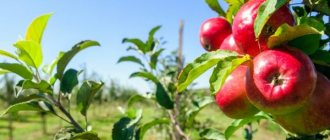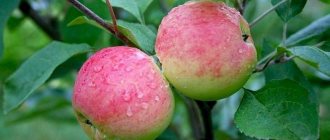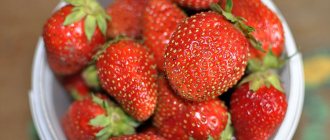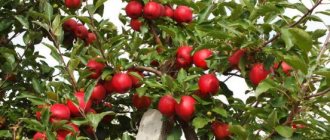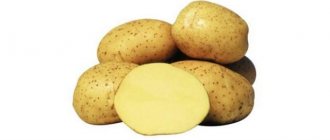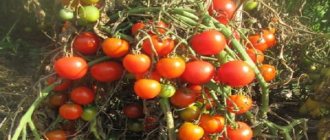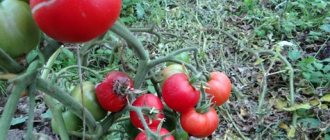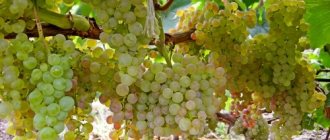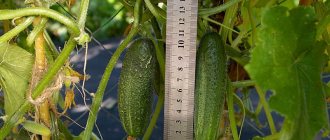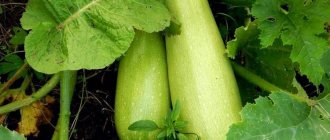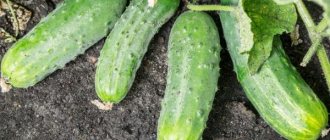External characteristics
The description of the plant highlights several external characteristics that allow the tree to be classified as this particular variety. Among them are the features of the crown, foliage, flowers, fruits, and height.
Crown
The crown is characterized by a sparse structure. Moreover, it has a rounded-cone shape. The strong skeletal branches point upward at an acute angle, and the lower branches are often drooping. The lower branches receive this direction due to the heaviness of the fruits.
Leaves
The variety is distinguished by large oblong smooth glossy leaves. In mature apple trees, the leaf blades may curl slightly. The edges of the leaves are double-toothed.
Reproduction methods
There are several ways to propagate an apple tree:
- seedlings;
- cuttings;
- seeds;
- young shoots.
The easiest way is to buy a ready-made seedling from a nursery and plant it. The apple tree will begin to bear fruit in the 4th-5th year. This is the fastest way to grow an apple tree.
For cuttings, material is prepared in the fall. Until February it is stored in a cool place. Towards the end of February, seedlings are taken out and planted in the ground at home. They will have time to take root before the weather warms up. In spring, the cuttings are transplanted outside.
Propagation by seeds takes a very long time. First you will have to germinate the seeds, then grow the seedlings for several months. It is better to plant seedlings in open ground a year after sowing the seeds. In the south, seedlings can be planted in the fall. It will take approximately 5-6 years before the apple tree begins to bear fruit. In addition, there is no guarantee that all seedlings will take root.
Another way is to dig up young shoots growing from an adult tree. The bushes are separated from the mother plant and replanted separately. The disadvantage of this method is that not all bushes retain the characteristics of the mother tree.
Flowers
The apple flowers of this variety are colored milky whitish. The shape of the flowers is saucer-shaped.
Fruit
Apples have a round, slightly conical shape. Their dimensions are quite large: the weight of one fruit reaches 150-230 grams.
Trunk
An adult apple tree has a fairly high trunk. When grown on a seed rootstock, the tree grows up to 3-4 meters in length. If a dwarf species is cultivated, the trunk height reaches 2-2.5 meters.
See also
Description and characteristics, advantages and disadvantages of Red Delicious apples, subtleties of cultivationRead
Advantages and disadvantages
The Mutsu apple tree has advantages and disadvantages.
Pros:
- low height on a dwarf rootstock, which makes tree care easier;
- good taste;
- hypoallergenicity of apples and the absence of coloring substances in their composition;
- high shelf life and the ability to transport over long distances.
Minuses:
- average frost resistance, requiring additional protection from winter cold;
- insufficiently good resistance to diseases and pests.
Advantages and disadvantages
Among the main advantages of the apple tree are:
- increased productivity;
- rapid fruit ripening;
- high consumer qualities of apples;
- good shelf life of the crop;
- presence of resistance to fungi.
There are no recorded deficiencies in this apple tree. But some gardeners claim that this variety is characterized by rare periodicity in fruiting.
Description of the variety
Mutsu got its name from the area where this variety was bred. Japanese breeders crossed two varieties: Golden Delicious and Indo in 1930. After the tests, the variety quickly spread in Japan, and then throughout the world.
Variety Mutsu (or Mutsu) is an apple tree with a wide pyramidal spreading crown. In the first years after planting, the tree grows quickly; with the onset of fruiting, growth slows down. The leaves are dark green with a pointed tip, the flowers are white. The fruits are yellow-green in color with barely noticeable white and black dots.
additional characteristics
It is also recommended to pay attention to other characteristics of the variety before planting. These include resistance to diseases, low temperatures, the possibility of self-pollination, and yield levels.
Immunity to disease
This variety of apple trees has average immunity to fungi. Basically, trees are affected by scab and powdery mildew when the humidity level increases.
Frost resistance
Apple trees have average resistance to low temperatures. If the tree is not given proper care and the ambient temperature drops below 35 degrees, the trunk freezes.
Pollination
This variety is not self-pollinating. In order for the tree to begin to bear fruit, other varieties of apple trees should be planted nearby. The best option for this is Jonathan, Idared.
Productivity and frequency of fruiting
This variety is characterized by a pronounced weakened periodicity in fruit formation. After a season of high harvest, the tree rests for 5-6 years.
Origin story
The apple tree was obtained in 1930, the country of origin is Japan, Mutsu Province. The local variety Indo and Golden Delicious were used for selection. The culture successfully passed the tests and quickly became famous in Japan. Later it was brought to Europe, Russia, and Ukraine.
Currently, the Mutsu variety is widespread in Ukraine and the southern regions. It is also popular in central Russia. The demand for seedlings in Russia is quite high.
Planting and care
To get a healthy plant, you need to follow all the principles of planting. Proper care of the apple tree is also necessary.
Planting technology
Before planting an apple tree, you need to know that this varietal species exhibits average resistance to severe frosts. To protect the plant, it is necessary to install a wind barrier on the north side.
Deadlines
Planting material must be planted in spring or autumn. The best option is to carry out planting work in the spring. This approach will give time for the root system of the seedling to adapt to the environment.
See also
Description and characteristics of the Kandil Orlovsky apple tree, planting and careRead
Pit distance and depth
Plantings should be located 3 meters from each other. The row spacing should form a gap of 4 meters. This arrangement allows mature trees to receive the maximum amount of sunlight and heat.
Maintain regular watering
In the first year of growth and development, the apple tree must be irrigated regularly. The best option is to provide watering 1-2 times a week. Gradually, the frequency of moisturizing needs to be reduced to once a month.
Fertilizer
It is best to plant an apple tree on black soil, fertile soil. If such conditions are absent, the soil must be fertilized with ash and humus. To improve fruiting in the spring, you need to apply nitrogen fertilizers under the tree, and in the fall - mineral complexes.
Loosening the soil
In order for air to enter the soil, it must be loosened. Loosening is required to be carried out at a depth of 10 centimeters. This procedure will strengthen the plant’s immunity and increase its productivity.
We carry out processing
During the growth and development of the apple tree, it is necessary to carefully inspect the tree for traces of pathologies and pests. If they are detected, it is necessary to immediately treat the affected areas.
Forming the crown
The apple tree does not need crown formation. Therefore, pruning is carried out only to eliminate damaged and old branches.
Preparing for winter
To prevent freezing, when late autumn approaches, the trunk should be wrapped with insulation. And cover the soil around the trunk with mulch and humus.
Collection and storage
Depending on the growing region, apples are harvested in September-November.
Only picked fruits are left for the winter. It is better to recycle the fallen ones.
Ideally, store apples in wooden or plastic boxes. Before laying, the fruits are sorted and then placed in prepared containers, sprinkled with sawdust or small wood shavings.
Warning! Only dry apples are stored. Excess moisture can cause rot.
Only picked apples are suitable for storage.
Where is the crop used?
Since the fruits of the variety are characterized by the presence of a dense skin, they can retain their freshness for a long time. This quality allows the harvested crop to be transported over long distances. The collected fruits, if stored in a cool, dark place, will not become deformed until May.
Also, during crop storage, it is necessary to monitor humidity levels: it should not be high. To get apples with a rich flavor, they need to be given time to ripen after harvesting. This takes 2 months.
Ripening and fruiting
The ripening and fruiting indicators of Mutsu are worthy of the attention of gardeners. An early onset of fruiting and high taste qualities of the fruit are what is required from a good variety.
Beginning of fruiting
Apple trees on a dwarf rootstock produce their first fruits already in the second year after planting, and on a seed rootstock – in the 3-4th year.
Peculiarities
At Mutsu, fruit twigs and last year's ringlets are strewn with fruits.
In the photo you can see what a tree with fruits looks like.
Apple tree with fruits.
Deadlines
The Mutsu apple variety is late winter, the fruits hang on the tree for a long time. During storage they do not lose their taste.
Maturation
Depending on the planting region, apple harvesting begins from mid-October to early November.
Fruit storage and harvesting
Two months after harvest, apples acquire a rich taste. They are covered with thick skin and do not deform during long-term storage. They are stored in specially equipped premises until May. Apples tolerate transportation well.
Apple harvest.
Regions of growth
Mutsu, an apple tree that has conquered a large area of Europe, is grown in private plots and in industrial gardening. The variety is cultivated in the Moscow region, central Russia and the Volga region. Also popular among gardeners in Ukraine and Belarus.
Mutsu (Mutsu, Crispin)
Winter apples, recognized by independent experts as one of the best varieties with light-colored fruits in the world, are Mutsu (other names: Mutsu or Crispin).
Obtained by Japanese breeders from crossing the cultivar Golden Delicious and Indo (a local variety of apple tree in Japan) according to some sources in 1930, according to others - in 1948.
It was named after the Japanese province of the same name where it was received.
Mutsu is not used in industrial plantings in Russia, but it is very popular among private owners and is grown in home and summer cottage plots in the south and central part of Russia and the CIS countries.
It has gained particular popularity with the development of active trade in seedlings in the last two decades.
The demand for planting material of this variety is consistently high and so far, according to professionals, there is a significant shortage of Mutsu seedlings.
Subtleties of agricultural technology
Considering the average winter hardiness of the variety, you should choose leveled places for planting, without depressions or depressions where cold air accumulates. If there is a slope, then only south orientation. The place must be protected from the north side from the cold wind; snow accumulation on the site must be maximum. Protection from rodents is needed - the installation of protective plastic nets.
Mutsu prefers soils that are nutritious, moisture-permeable and breathable. The ideal option is chernozems, but with a sufficient amount of fertilizer (5-6 kg per 1 m2 for digging the soil in the fall and 1-2 kg in combination with a tablespoon of wood ash in the hole when planting) and moisture (2-3 buckets of water every two weeks until early September) can be grown on loam and sandy loam.
On dense clay soil, a drainage layer (pebbles, expanded clay) 3-4 cm thick and a baking powder in the form of river sand (half a bucket) must be added to each planting hole.
Mutsu is more productive in an open and well-lit place; it can grow in the shade, but yields are reduced by up to 50%. This is evidenced by numerous reviews.
Trees do not need frequent pruning; sanitary pruning can be carried out by removing dry and broken shoots once every 5-6 years, starting from the age of seven.
It does not tolerate waterlogging or close groundwater; their level should not be higher than 2.5 m to the soil surface.
Planting pattern: 4 meters between rows and 3-3.5 meters between plants.
It is better to plant in the spring. To avoid purchasing completely the wrong variety, it is better to purchase seedlings from specialized nurseries with varietal certificates, checking the description of the variety and relying on photos. To avoid contamination of the site with a quarantine infection, seedlings must be purchased locally produced, not imported.
Advantages
Low tree growth, early fruiting, good yield on nutritious, moisture-rich soil, excellent transportability of products, ability for long-term storage, excellent taste of fruits.
Reviews
Schmidt. T.M. St. Petersburg. "Hello. I would like to share with you my opinion about the Mutsu variety. This apple tree has been growing in my dacha for 15 years. I planted it on the recommendation of a gardener friend. Now, whenever I meet, I always thank him for his advice.
The tree is unpretentious in care. I do pruning extremely rarely. Scab infection goes away quickly. There was no periodicity in fruiting. Productivity increases every year. Last year, my husband and I collected more than 70 kg of fruit. The apples are large, sweet, with a pleasant aroma. We use them fresh and processed. As soon as the apples begin to deform during storage, I prepare various preserves from them.”
Elena. Novosibirsk region. "Good afternoon! I heard good reviews and recommendations about the Mutsu variety. In turn, I would like to refute this opinion. The apple tree is constantly exposed to scab, fruit rot and powdery mildew. In winter, the branches freeze. The harvest is unstable. The fruits have a very hard skin. Apples can be stored for quite a long time, but when preserved they lose their aroma and taste.”
More on Tele4n.Net:
Apple tree Dessert Petrova: description of the variety with photos and reviews from gardeners
Eugene. Yekaterinburg city. “Good day, amateur gardeners!!! In turn, I would like to recommend the Mutsu apple tree variety for each summer cottage. The apple tree has many advantages over other similar crops.
Due to the low growth of the tree, care and pruning are easy to use. The yield is high if all cultivation characteristics are observed. Fruits of commercial and consumer qualities. Apples are transportable and retain their quality for quite a long time. They can be consumed fresh both when picked and in the spring.”
Apple tree Mutsu NK
Apple tree Mutsu Nk is a mutant of the Mutsu variety . The fruit crop was developed in Poland. The variety is characterized by average resistance to frost and fungal diseases . The apple tree begins to bear fruit early, without further periodicity.
The fruits are cone-shaped, large, weighing 300 g . The skin is smooth, light green in color. The flesh is juicy, but less sweet than that of the Mutsu variety . The advantages of this crop include good adaptation to climatic conditions and soil.
Apple tree Mutsu Nk.
